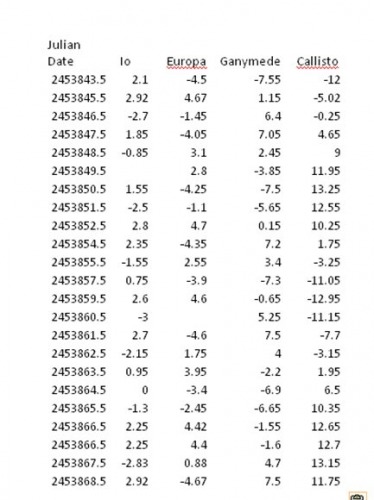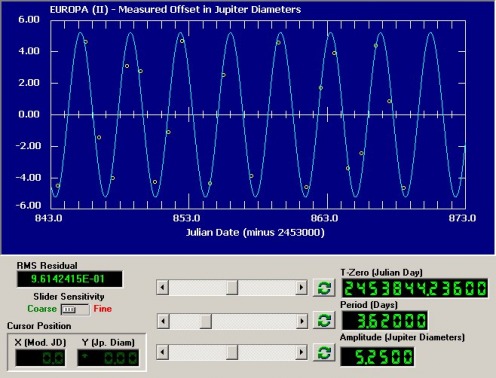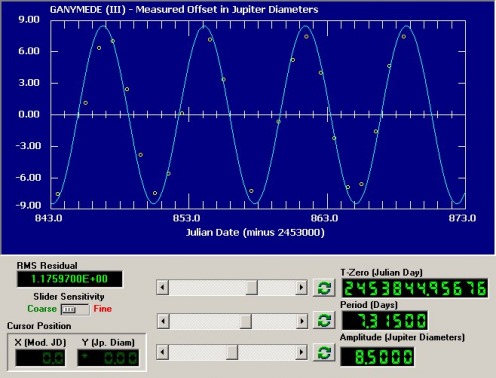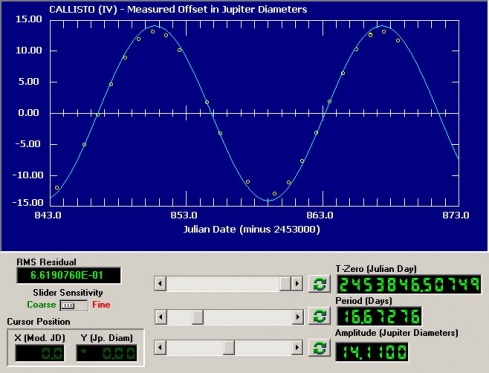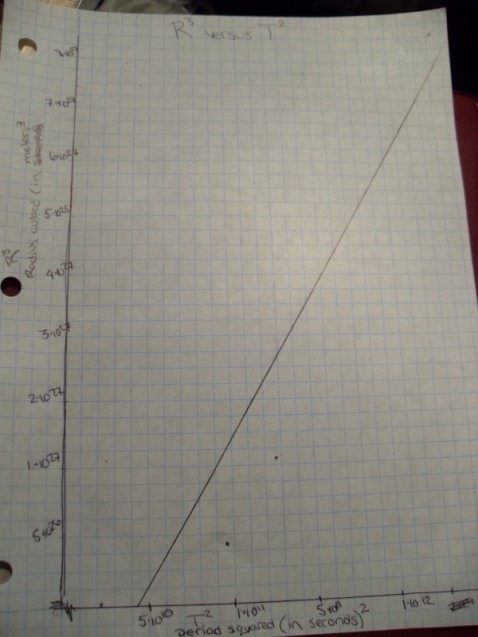Jupiter's Moons
Objective
Calculate the mass of Jupiter by examining its moons.
Background
From Newton's Law of Gravitation, we know that
F(g) = GmM/r^2
Where F(g) = m*v^2/r
So
m*v^2/r = GmM/r^2
v^2 = GM/r v = w*r (w represents omega)
w^2*r^2 = GM/r w = 2*(pi)/T
4*(pi)^2/T^2 = GM/r^3
r^3/T^2 = GM/4*(pi)^2
Therefor, the slope of the r-cubed vs. time-squared graph must equal GM/4*(pi)^2
F(g) = GmM/r^2
Where F(g) = m*v^2/r
So
m*v^2/r = GmM/r^2
v^2 = GM/r v = w*r (w represents omega)
w^2*r^2 = GM/r w = 2*(pi)/T
4*(pi)^2/T^2 = GM/r^3
r^3/T^2 = GM/4*(pi)^2
Therefor, the slope of the r-cubed vs. time-squared graph must equal GM/4*(pi)^2
Procedure
Geddes, Kimberly. "Moons of Jupiter." Mrs. Geddes' AP Physics Lab. N.p., n.d. Web. 31 Mar 2010. <http://geddesphysics.weebly.com/moons-of-jupiter.html>.
Data
Data Analysis
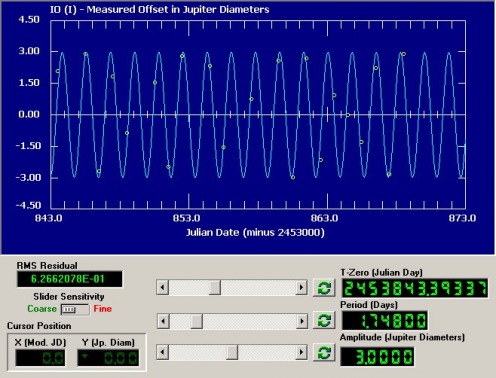
Paragraph.
Data Points to Graph
(22809215140, 7.89536E25)
(97823821824, 4.23142E26)
(3.99444E11, 1.14459E27)
(2.07512E12, 8.21465E27)
(97823821824, 4.23142E26)
(3.99444E11, 1.14459E27)
(2.07512E12, 8.21465E27)
Calculations
Between Newton's Law of Gravitation and Kepler's Third Law, we know that
R^3/T^2 = GM/4(pi)^2
Where R is the radius (assuming circlular orbit) of the moon's orbit and T is its period.
R^3/T^2 = GM/4(pi)^2
Where R is the radius (assuming circlular orbit) of the moon's orbit and T is its period.
Slope is roughly 43.95e15
3.95e15 = GM/4*(pi)^2 G = 6.67e-11
2.33e27 = M Yay!!!!!!
3.95e15 = GM/4*(pi)^2 G = 6.67e-11
2.33e27 = M Yay!!!!!!
CONCLUSION.
Percent error: (calculated - accepted)/accepted
(2.33e27-1.8986e27)/1.8986e27
23% error
Moons beyond Callisto will have a greater period than Callisto itself. They will not only have farther to move, but will also not have as great a force of gravity acting upon them ,because they are father away; this means less acceleration.
An error in the 'r' value would have a much greater affect than an error in the 'T' value, because it 'r' is cubed, and the 'T' value is merely squared. This could have been my own issue; looking back, my sine curves had a bit too great an amplitude than was best fit.
With his observations of Jupiter's moons, Galileo could then study the movements of the other planets. If he were to apply the same concept to the planets, he would discover that they were being acted upon by a center with a much larger mass than the Earth could have contained; he could then look to the Great Body of the sun.
(2.33e27-1.8986e27)/1.8986e27
23% error
Moons beyond Callisto will have a greater period than Callisto itself. They will not only have farther to move, but will also not have as great a force of gravity acting upon them ,because they are father away; this means less acceleration.
An error in the 'r' value would have a much greater affect than an error in the 'T' value, because it 'r' is cubed, and the 'T' value is merely squared. This could have been my own issue; looking back, my sine curves had a bit too great an amplitude than was best fit.
With his observations of Jupiter's moons, Galileo could then study the movements of the other planets. If he were to apply the same concept to the planets, he would discover that they were being acted upon by a center with a much larger mass than the Earth could have contained; he could then look to the Great Body of the sun.
